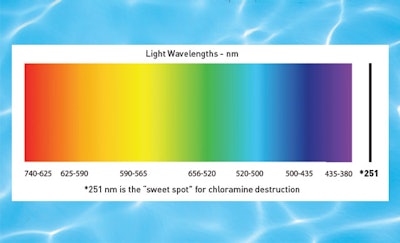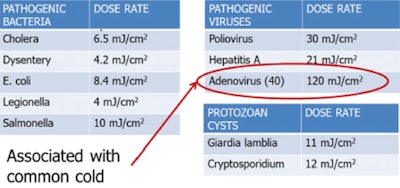
In recent years, the need for more sanitation for public pools has become very clear. Keeping recreational water safe for bathers oftentimes requires more than the standard halogen-based sanitizer, such as chlorine, so Ultraviolet (UV) Light Secondary Disinfection Systems have been added to many public pools. At the same time, some residential pool owners have incorporated UV systems into their sanitation regimen in order to improve overall results and reduce chlorine use.
If used correctly, UV systems can help provide safe recreational water to ensure bather safety from waterborne pathogens. Additionally, there is a new class of UV products now classified as "Water Conditioning Devices" that improve water and air quality of aquatic facilities. These new devices are being used predominantly with indoor pools to improve the indoor air quality but are neither secondary disinfection systems nor sanitizers.
THE BASICS OF UV
A. Wavelength
UV light is a range of short wavelength (10 – 400 nanometers) light that is invisible to the naked eye.
B. Medium-Pressure UV Light Systems
Medium-Pressure UV Light Systems are defined by the UV light spectrum in which they operate. They operate in a wavelength range starting at approximately 250 nanometers (nm) to well over 600 nm. The lamps operate at temperatures in excess of 1,500 degrees Fahrenheit. They were originally used for drinking water sanitation. UV light in this range of wavelengths can react with a wide variety of chemicals in the water and can deactivate chlorine sanitizers. This is a problem when used to treat swimming pool water, because it would require higher amounts of sanitizer and thus, increase operating cost. These units are effective in removing chloramines through a process known as photolysis, a chemical reaction involving light.
C. Low-Pressure UV Light Systems
Low-Pressure UV Light Systems are defined by the light spectrum in which they operate. This operating wavelength range is very narrow, at approximately 190 nm to 254 nm. The wavelength of 254 nm is known as the "sweet spot" for chloramine destruction. This wavelength does not affect free chlorine, and the system operates at approximately 140 degrees Fahrenheit. The low operating temperature and the non-destruction of chlorine make these systems very cost effective to operate.
D. Secondary Disinfection UV Light Systems
Secondary Disinfection UV Light Systems are required on any "increased risk aquatic venue," defined in ANSI/APSP/ICC-11 2019 as "an aquatic venue which has an increased risk of microbial contamination due to its primary users being children under the age of five and/or people more susceptible to infection, such as therapy patients with open wounds. Examples of increased risk aquatic venues include spray pads, wading pools, therapy pools and other aquatic venues designed primarily for children under the age of five."
The reason for this requirement is that some pathogens, such as Cryptosporidium, are resistant to halogen-based sanitizers such as chlorine. UV light systems can inactivate the pathogens on a single pass through the UV reactor. This will help prevent many types of known infections and makes the recreational water safer for bathers. Medium-Pressure UV Light Systems are primarily used for secondary disinfection. Additionally, manufacturers have tested and received NSF/ANSI/CAN 50 approval for Low-Pressure UV Light Systems which may also be used. To qualify as a secondary disinfection system, a 3-Log 99.99% reduction of Cryptosporidium must be achieved.
E. Supplemental Disinfection UV Light Systems
Supplemental Disinfection UV Light Systems may be installed on any aquatic venue other than an increased risk aquatic venue, and these systems are certified to inactivate most waterborne pathogens other than Cryptosporidium. The majority of Supplemental Disinfection UV Light Systems are medium-pressure systems, which increase chlorine consumption, and therefore increase the operational cost.
F. Water Conditioning Device
UV light systems are the newest addition to UV light products. These systems are not sanitizers. They use low-pressure UV lamps and operate at 254 nm — the wavelength proven to be most effective in chloramine destruction. As compared to Low Pressure UV Systems described above, Water Conditioning Devices are not intended to be used as either supplemental or secondary sanitizers, but rather, to improve water quality and the poor air quality an indoor pool can provide. There is substantial evidence that prolonged exposure to indoor pool air can produce respiratory problems.
 Microorganism Inactivation Charts with UV Dose Rates to Achieve a 4-Log Inactivation
Microorganism Inactivation Charts with UV Dose Rates to Achieve a 4-Log Inactivation
G. UV Light Dosage is the Key
Whether talking about a secondary, supplemental or a water conditioning device, the dosage is the most important factor. UV dosage is dependent on three key items. First: What is the Ultraviolet Transmittance (UVT) of the water? Certain contaminants, such as iron, disrupt the transmission of UV light through the water, even though the water may appear to be very clear.
The second consideration is the power of the UV lamp itself, rated in millijoules per square centimeter (mj/cm2). The dosage needed to destroy monochloramines is 60 mj/cm2 for indoor pools and 40 mj/cm2 for outdoor pools.
The third consideration is the flow rate of the water through the UV system. The slower the flow rate, the greater contact time at the point where the water is exposed to the UV light, thus a higher dosage is achieved. UV products are rated at dosages depending on the flow rate.
RELATED: UV: A Sanitizing Assist for Hot Tubs
Various microorganisms require different dosages to deactivate them. In the majority of cases UV light reacts faster at deactivating microorganisms than the recommended amount of sanitizer (chlorine/bromine) in recreational water does. However, the common cold virus, for example, is resistant to UV light and is easily deactivated by the recreational water sanitizer, such as chlorine or bromine.
Water flow rate affects the UV system dosage (see chart above). Therefore, balancing the use of UV light systems at required flow rates with appropriate amounts of sanitizers (chlorine/ bromine) can help provide a safe swimming environment.
 Effect of Flow Rates and Dose Rates
Effect of Flow Rates and Dose Rates
HOW IT'S APPLIED
UV treatment is an extremely quick physical process. In a UV disinfection process, water is passed through a chamber containing a UV lamp. As the water flows through the chamber, microorganisms in the water are exposed to UV radiation generated by the mercury arc UV lamp. When UV radiation penetrates the cell wall of the microorganism, it destroys the cell's ability to reproduce by mutating/ degrading its genetic material (DNA and RNA). When the genetic material is sufficiently damaged, the microorganism cannot function or reproduce, which renders it harmless.
Many local codes will require a "Secondary UV Light" System to be installed to ensure bather safety. Water conditioning UV light systems are becoming increasingly common for indoor pools because they are proven to be effective in destroying problematic chloramines, thus helping to improve the air quality for bathers. Poor air quality is considered one of the most important dangers to bather health by most industry experts. UV products are also commonly used with spray pads as are often classified as increased risk aquatic venues due to their use by children.
MAINTENANCE AND PRECAUTIONS
- Maintenance is very important to ensure UV light products are working correctly. Medium-pressure units require the most care since they operate at such high temperatures — the glass sleeve that contains the UV lamp can become coated with calcium and other contaminants. These units sometimes include "wipers" to automatically clean the sleeves. Lamps also need to be replaced frequently. All required maintenance increases operating costs and energy consumption.
- Low-pressure UV light products require much less care. The lamps can operate much longer than medium-pressure units before they require replacement. They cost less and their operating cost is less. Because they operate in a narrow wavelength range, they do not destroy free chlorine. They also operate directly at the 254 nm-wavelength, which is the best for pathogen and chloramine destruction.
- When using UV equipment, it is necessary to follow all applicable electrical codes and precautions. Turn off power at the main source before servicing or making electrical connections. Always follow manufacturer's use instructions when operating and maintaining the UV system.
- UV light can cause serious damage to eyes and skin. Do not handle or stare at an operating UV lamp.
This article first appeared in the February 2021 issue of AQUA Magazine — the top resource for retailers, builders and service pros in the pool and spa industry. Subscriptions to the print magazine are free to all industry professionals. Click here to subscribe.











































